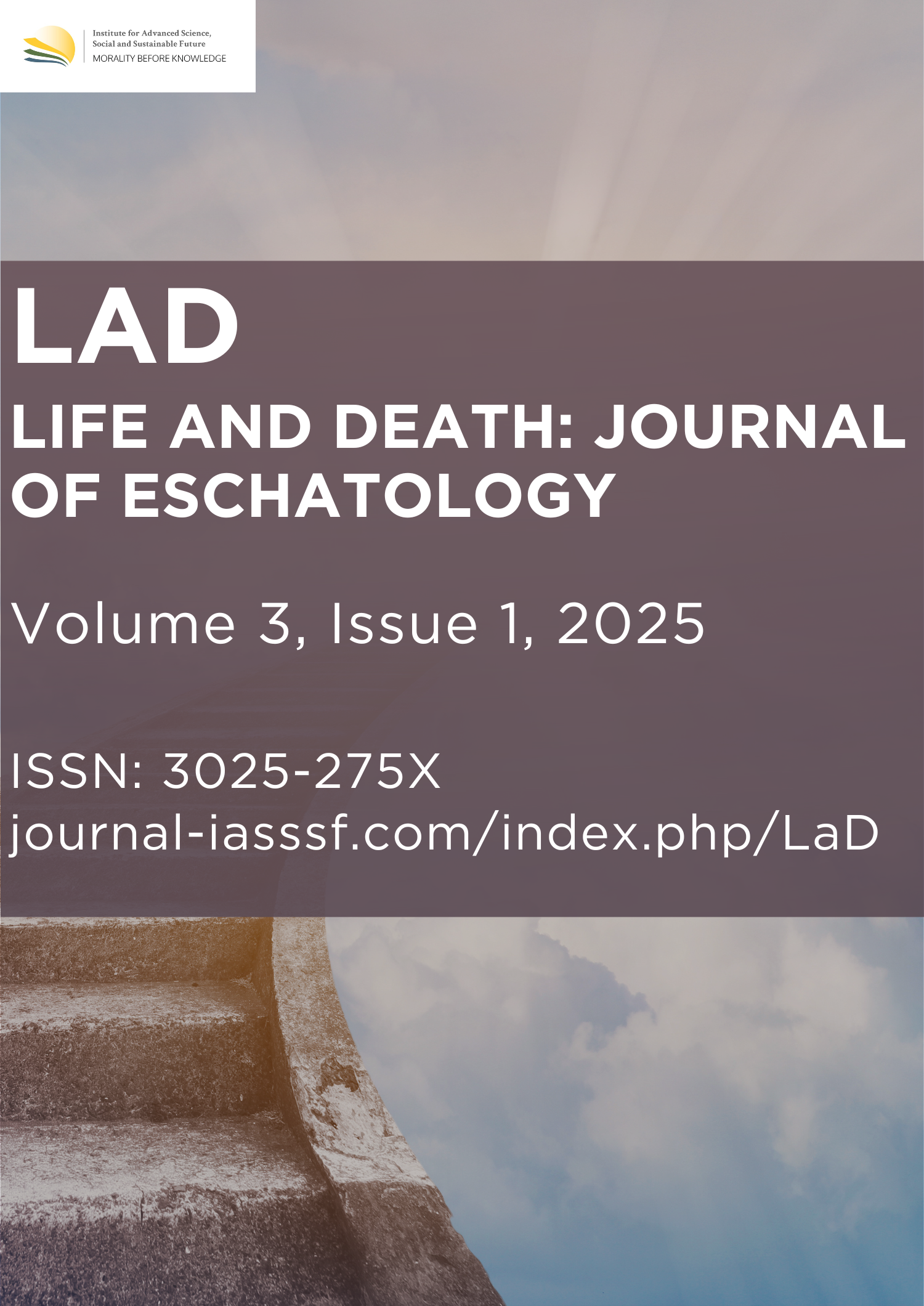The importance of the teachings of the bhagavad-gita in hindu society in Bali
DOI:
https://doi.org/10.61511/lad.v3i1.2025.1578Keywords:
bhagavad-gita, hindu religion, society, vedasAbstract
Background: The Bhagavad Gita is one part of the Vedas, and it is also referred to as the fifth Veda or Pancama Veda. The history of the growth of the Vedas is fundamentally known as the Veda Trayi, which consists of the Rig Veda, Sama Veda, and Yajur Veda. The Atharva Veda contains various magical mantras. Structurally, the Bhagavad Gita is more directed and serves as a compilation of the previous Vedas. This represents a step in the historical development of Hindu thought.In-depth and extensive research has proven that, as mentioned in the Puranas, the codification of the Four Vedas is the greatest achievement of Bhagawan Abiasa (Vyasa). Methods: This study employs a qualitative descriptive approach using interviews and questionnaires to explore how the teachings of the Bhagavad Gita are understood and practiced among Hindu students and communities in Bali. The data were collected from student responses and analyzed thematically. Findings: The majority of respondents acknowledge the Bhagavad Gita as a sacred scripture that plays an essential role in shaping values such as dharma (duty), karma yoga (selfless action), devotion, self-control, and emotional resilience. Respondents emphasized its relevance in daily life, particularly in building character, facing modern challenges, and fostering communal harmony. A bar chart analysis revealed that 28 out of 30 respondents stated that the Bhagavad Gita “strongly influences” their daily lives. Conclusion: The teachings of the Bhagavad Gita are not only regarded as religious doctrine but also as a comprehensive guide for ethical behavior and emotional well-being in both personal and social contexts. Its philosophical messages remain highly relevant and are deeply internalized by the Hindu community in Bali, especially among students who use its values to navigate contemporary challenges. Novelty/Originality of this article: This study highlights the lived experience of Balinese Hindu students with the Bhagavad Gita, showing how an ancient spiritual text continues to inform practical moral choices in modern society.
References
Aryadharma, N. K. S. (2019). Vedānta & the method of understanding Hindu philosophy. Paramita.
Bakker, E. (2016). Balinese Hinduism: Ritual, culture, and the intersection of tradition and modernity. Bijdragen tot de Taal-, Land- en Volkenkunde. https://www.jstor.org/stable/27864809
Chatterjee, D. (2024). A critical analysis of the psychological concepts in the Bhagavad Gita. University of Edinburgh. https://dx.doi.org/10.2139/ssrn.4815485
Darmayasa, A. (2015). Bhagavad Gita (Song of God). Yayasan Dharma Sthapanam.
Desai, M. (2020). Gita According To Gandhi: Gita According to Gandhi: Mahadev Desai's Interpretation of the Bhagavad Gita by Mahadev Desai. Prabhat Prakashan.
Dhillon, M. (2023). Weaving together the ancient and the contemporary: Intersections of the Bhagavad Gita with modern psychology. Pastoral psychology, 72(4), 525-537. https://doi.org/10.1007/s11089-023-01070-2
Edgerton, F. (2010). The Bhagavad Gita: An introduction to its teachings. Harvard University.
Fitzgerald, J. (2019). The Mahābhārata: the epic of the greater good. J. Gonda Fund Foundation of the KNAW.
Frazier, J. (2021). Ethics in classical Hindu philosophy: Provinces of consequence, agency, and value in the bhagavad gītā and other epic and śāstric texts. Religions, 12(11), 1029. https://doi.org/10.3390/rel12111029
Geertz, C. (1973). The interpretation of cultures: Selected essays. Basic Books. (Chapter 5: Religion as a cultural system)
Hamsah, U. (2003). Konsep etika dalam Bhagavadgita. Jurnal Filsafat, 13(3), 271–278. https://doi.org/10.22146/jf.31301
Ježić, M. (2022). The Bhagavad Gītā: Genesis of the text, its messages, and its impact on the Mahābhārata and on Indian religions and philosophy. Wiley Blackwell Companion to Hinduism, 105-127. https://doi.org/10.1002/9781119144892.ch7
Kosuta, M. (2020). Ethics of war and ritual: The Bhagavad-Gita and Mahabharata as test cases. Journal of Military Ethics, 19(3), 186-200. https://doi.org/10.1080/15027570.2020.1824578
Maitra, K. (2022). Consciousness and attention in the Bhagavad Gita. Journal of the American Philosophical Association, 8(2), 191-207. https://doi.org/10.1017/apa.2020.23
Marselinawati, P. S. (2020). Filsafat Ketuhanan Dalam Bhagavad Gita. Genta Hredaya: Media Informasi Ilmiah Jurusan Brahma Widya STAHN Mpu Kuturan Singaraja, 3(1).
Milner, H. V. (2021). Voting for populism in Europe: Globalization, technological change, and the extreme right. Comparative Political Studies, 54(13), 2286-2320. https://doi.org/10.1177/0010414021997175
Nagar, P. (2021). Management Education Lessons From The Bhagavad Gita. Journal of Global Information and Business Strategies, 13(1), 99-108. https://dx.doi.org/10.2139/ssrn.3579987
Nayak, B. S. (2022). Bhagavad Gita and Hindu modes of capitalist accumulation in India. In Political economy of development and business: Towards decolonisation, transformation and alternative perspectives (pp. 119-136). Cham: Springer International Publishing. https://doi.org/10.1007/978-3-031-11093-1_8
Nurcahyo, A. D., Astuti, N. L. P. W., & Setyaningsih. (2024). Implementasi kebiasaan membaca Bhagavad Gita dalam membangun karakter religius siswa Hindu SMPN 3 Muncar. Widya Aksara: Journal of Hindu Religion, 29(2), 115–129. https://ejournal.sthd-jateng.ac.id/index.php/WidyaAksara/article/view/287/188
Paudel, J. (2023). The rhetoric of the Bhagavad Gita: Unpacking persuasive strategies from a non-western perspective. Rhetoric Society Quarterly, 53(2), 172-185. https://doi.org/10.1080/02773945.2022.2095421
Puja, G. (1999). Bhagavad-Gita Pancama Weda. Paramita.
Raharjo, S. B., Pranawa, B., Sutarni, N., & Saputri, A. M. W. (2024). The Impact of Globalization of Technology on Treatment and Care Systems For People with Mental Disorders. Asian Journal of Social and Humanities, 2(9), 2005-2011. https://doi.org/10.59888/ajosh.v2i9.338
Ropu, M. H. H., & Syukur, M. (2025). Perubahan Paradigma Interaksi Sosial Generasi Z Dalam Konteks Globalisasi. Jurnal Penelitian Pendidikan Sosial Humaniora, 10(1), 15-22. https://www.jurnal-lp2m.umnaw.ac.id/index.php/JP2SH/article/view/3860
Sivananda, S. (2000). Bhagavad Gita: English translation by Swami Sivananda. Bhagavad Gita Online. https://www.dlshq.org/download2/bgita.pdf
Sriasih, S. A. P., Yasa, I. N., Indriani, M. S., & Iragraha, S. M. F. (2022). Pelatihan Dan Pendampingan Pembacaan Bhagavad Gita Pada Siswa Kelas V Sekolah Dasar Mutiara Singaraja. In Proceedings of the National Seminar on Community Service (Senadimas) (pp. 1994–2000). Universitas Pendidikan Ganesha. https://conference.undiksha.ac.id/senadimas/2022/prosiding/file/267.pdf
Sudiarja, A. (2012). Reading the Bhagavad-Gita together with Prof. R. C. Zaehner (I. P. Baryadi, Ed.; T. A. Hermawan, Contributor). Sanata Dharma University Press.
Suhardana, K.M. (2007). Tri Kaya Parisudha Bahan Kajian Untuk Berpikir Baik, Berkata Baik dan Berbuat Baik. Paramita.Suhardana.
Surpi, N. K. (2024). The power of 33 sloka Bhagavad Gita. PT. Dharma Pustaka Utama.
Suwitri, N. W. (2024). Strategi Menjaga Kearifan Lokal Dan Membangun Toleransi Di Tengah Masyarakat Multikultural Pada Era Globalisasi (Kajian Pendidikan Agama Hindu). JURDIKSCA: Jurnal Pendidikan Agama Hindu Mahasiswa Pascasarjana, 3(2), 50-61. https://journal.stahnmpukuturan.ac.id/index.php/jurdiksca/article/view/702
Wiguna, I. K. J. (2025). Examining the variables influencing religious leaders' interest in Bhagavad Gita studies: A case study of susut sub-district. Dharmakirti: International Journal of Religion, Mind and Science, 2(2), 92-104. https://doi.org/10.61511/ijroms.v2i2.2025.1561
Downloads
Published
How to Cite
Issue
Section
Citation Check
License
Copyright (c) 2025 I Putu Dendy Arianta

This work is licensed under a Creative Commons Attribution 4.0 International License.
















